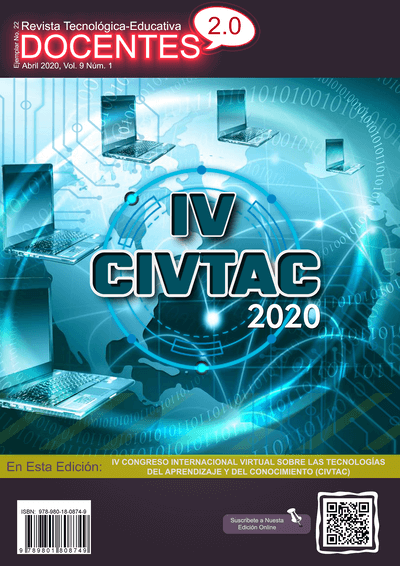Tools of a mobile instant messaging application for strengthening the Teaching - learning process of English.
 DOI:
https://doi.org/10.37843/rted.v9i1.109
DOI:
https://doi.org/10.37843/rted.v9i1.109
Main Article Content
Abstract
The present study seeks to optimize the use of mobile devices in the learning environment (classroom), using a mobile application for instant messaging for massive use, taking advantage of the sending of information through audio, video, images and text, in order to strengthen the learning of English in the apprentices of a training program, in the Agroindustrial Training Center "La Angostura", of the National Learning Service SENA (Colombia). The focus of this research is of a sequential mixed nature, with emphasis on the qualitative, since the activities carried out with the mobile application in four phases are described. The application through the mobile device is evaluated through the Koole FRAME model and the device capabilities or Quinn 4 C. The results show that English learning can be strengthened, motivates autonomous work, fosters collaborative work and improves digital competence. Finally, mobile learning is characterized because “the student will develop their cognitive abilities through interaction, having as support the technology and the tools it provides” (Gómez, 2016).
Downloads
Metrics
Article Details

This work is licensed under a Creative Commons Attribution-NonCommercial-NoDerivatives 4.0 International License.
Those authors who have publications in our journal accept the following terms:
- When a work is accepted for publication, the author retains rights of reproduction, distribution of his/her article for exploitation in all countries of the world in the format provided by our magazine and any other magnetic medium, optical, and digital.
- Authors will retain their copyright and guarantee the journal the right first to publish their work, which will be simultaneously subject to the Creative Commons Acknowledgment License (Attribution-NonCommercial-NoDerivatives 4.0 International (CC BY-NC-ND 4.0)). That allows third parties to copy and redistribute the material in any medium or format, under the following conditions: Acknowledgment - You must properly acknowledge authorship, provide a link to the license, and indicate if any changes have been made. You may do so in any reasonable way, but not in a way that suggests you have the licensor's endorsement or receive it for your use. NonCommercial - You may not use the material for a commercial purpose. NoDerivatives - If you remix, transform, or build from the material, you cannot broadcast the modified material. There are no additional restrictions - You cannot apply legal terms or technological measures that legally restrict you from doing what the license allows.
- Authors may adopt other non-exclusive license agreements to distribute the published version of the work (e.g., deposit it in an institutional archive or publish it in a monographic volume) provided that the initial publication in this journal is indicated.
- Authors are allowed and recommended to disseminate their work through the Internet (e.g., in institutional telematic archives, repositories, libraries, or their website), producing exciting exchanges and increasing the published work's citations.
- Request of withdrawal an article has to be done in writing by the author to the Editor, becoming effective after a written response from the Editor. For this purpose, the author or authors will send correspondence via e-mail: [email protected].
- The author will not receive financial compensation for the publication of his work.
- All Docentes 2.0 Journal publications are under the Open Journal System (OJS) platform at: https://ojs.docentes20.com/.
References
Gómez, S (2014). Introducción y fundamentos del aprendizaje móvil. UMB Virtual. Maestría en Tecnologías digitales aplicadas a la educación Cajicá, Colombia.
Hernández R, Fernández C & Baptista P (2006). Metodología de la investigación. McGraw Hil. Cuarta edición, 2006.
Koole, M. L. (2009). A model for framing mobile learning. Mobile learning: Transforming the delivery of education and training, 1(2), 25-47.
Quinn, C. (2000), M-learning: Mobile, Wireless, In-your–pocket learning. LineZine.http://www.linezine.com/2.1/features/cqmmwiyp.htm
Rodríguez, G., Gil, J. y García, E. (1996). Metodología de la Investigación Cualitativa. Ediciones Aljibe.
Tecnosfera (2017). Los colombianos pasan 100 minutos diarios conectados a sus celulares. http://www.eltiempo.com/tecnosfera/novedades-tecnologia/habitos-de-consumo-en-el-uso-de-dispositivos-moviles-en-colombia-96270.






